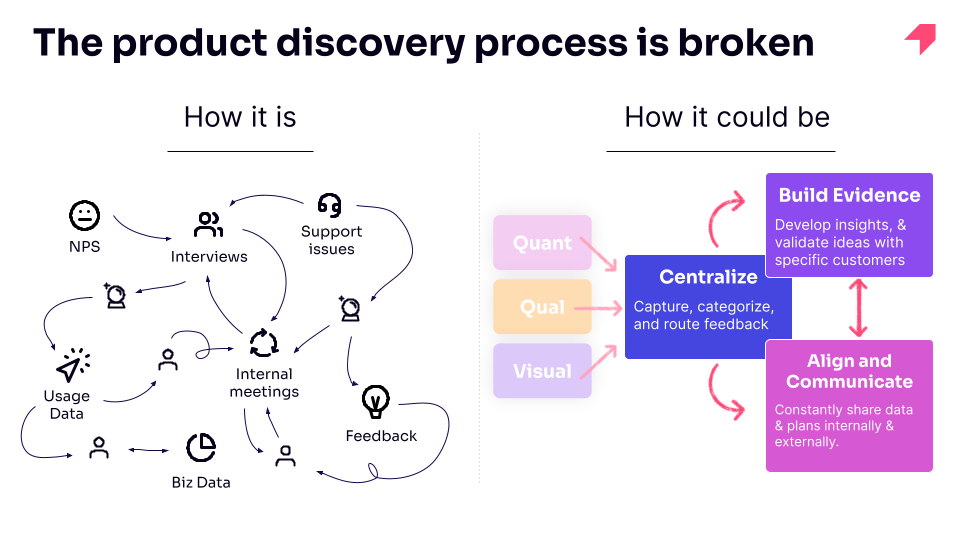Ship fast—but make sure the product looks slick. Build that swanky new feature—but do it on a shoestring budget. Make sure we don’t just have parity with competitors—but that we outperform their offerings and get to market faster.
When speed and urgency are at the forefront of leadership’s minds, it can be easy for product managers (PMs) to throw their hands up and say, “We don’t need to waste time with product discovery, we already know our users!” But not prioritizing product discovery—or not approaching it the right way—can have serious implications for your product, from bad product-market fit to bugs to features that go unused.
Let’s explore four key ways the product discovery process is broken for many teams—and how to fix it in order to create a repeatable, reliable, data-driven discovery engine.
1. You’re not doing product discovery at all
According to our research, about 80% of software products are rarely or never used. That’s an astonishing $29.5B of wasted R&D spend each year. If your team doesn’t leverage any kind of product discovery tactics, it’s likely that your product is part of this statistic. Product discovery is an important step teams can take to mitigate risks and reduce the chances of developing a product that fails to meet user expectations or market demands.
In the era where digital experiences are king, not prioritizing product discovery can result in your product—and your entire organization—coming across as “tone deaf” to user desires, or incapable of delivering the offerings your customers actually need to succeed in their roles. But by conducting thorough product discovery, you can gain an objective understanding of what your users actually want, make smarter decisions about where to focus your time and resources, and identify potential challenges early in the product development process. This ultimately saves you from making poor investments or expensive (even reputation-ruining) missteps.
A product discovery motion is also a valuable tool for aligning the product development process with your business’ overarching goals. By taking the time to understand users’ needs, ideating on the best path forward to meet those needs, and ensuring those planned solutions ladder up to the company’s larger objectives, product teams can maximize the visibility—and impact—of the product on the organization’s overall success.
2. You’re unable to sift through all the noise
When it comes to product discovery, many product teams struggle with the dreaded “analysis paralysis.” In other words, they’re swimming in a sea of information—often housed in multiple disparate tools and originating from a number of different sources—with no clear idea of how to act on it.
With the abundance of data available (e.g. product usage, customer and seller feedback, and market intelligence, just to name a few), it’s not uncommon for product teams to struggle to make sense of all this information. This slows down the entire product discovery and development process, and even leads PMs to fall back on biases in their decision-making in an attempt to find a direction to start moving in.
The best product discovery tools help product teams distinguish between valuable insights and noise. It’s not enough to simply listen to the loudest opinion or most common topic that arises from user focus groups. Nor is it enough to periodically take a pulse from your voice of the customer (VoC) program. Today, product teams need continuous discovery that unifies all the quantitative, qualitative, and visual data at their disposal in a single platform—making it easier and more efficient for them to identify themes and act on them. Pendo Listen was designed to solve this problem, by helping teams centralize feedback (in all its forms), prioritize it, and communicate updates to internal and/or external stakeholders, at scale—creating a holistic resource for continuous product discovery.
3. You’re not capturing the right signals
Another common struggle is not leveraging the right data sources for product discovery—in other words, not capturing the right signals to make the best, informed decisions. For example, some teams over index on anecdotal feedback from customers or solely rely on feedback from user interviews to determine what to prioritize in their product. But without other quantitative, objective inputs like product analytics or session replays, they’re lacking a complete view into the user experience to guide their discovery.
Verifying ideas effectively before investing significant resources in development can also be challenging for product teams. In other words, even a team’s best laid plans can backfire because they’re unable to validate the efficacy of their new offerings before rolling them out across their entire user base. Validate—part of Pendo Discover—solves this problem.
Once you have an idea of the problems your customers face (and potential solutions to solve them), Validate helps you know what to build—and why. It allows product teams to prioritize and justify product investments by collecting in-app feedback from specific customers who rank the options you present to them. This makes it easy to verify and test ideas at scale, before a full rollout.

4. You’re not thinking about discovery in the context of the product life cycle
Building great products doesn’t end at go-live. In the same way that the product management life cycle is cyclical and continuous, so is product discovery. But many product teams struggle to find the time to incorporate discovery into their ongoing optimization efforts. It’s also not uncommon for product teams to view product discovery as something that only needs to happen before launching a new product or feature—rather than something that continually informs their strategy.
Throughout the product life cycle, PMs need to make strategic decisions about features, updates, and fixes. Informed decision-making, rooted in product discovery insights from all the quantitative and qualitative data at their disposal, ensures that their choices align with the evolving needs of users and the market. And because markets and user needs can change, continuous discovery also ensures that product teams are building the right things and adapting to respond to customer desires at every stage of the customer journey—not falling behind.
Even when it comes to sunsetting products or features, product discovery can help in deprecation planning, managing customer transitions, and exploring opportunities for new products or features. Because Pendo Listen is designed to help teams collect and act on product insights (and communicate subsequent plans), it’s a powerful tool to enable discovery at every stage of the product life cycle. It allows you to share evidence as you uncover it, keep stakeholders updated on requests, and build easy-to-share roadmaps—while keeping everyone aligned throughout the process.
If you want to improve how your team does product discovery, take a tour of Pendo Listen or request your demo.


